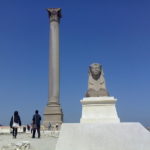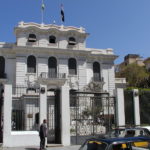
Greco-Roman Museum
features artifacts from a fascinating period in Egyptian history when Greek, Roman, and Ancient Egyptian civilization all interacted here, resulting in an interesting fusion of traditions. In this small museum you will come in contact with several legendary figures from world history, all of who played out important parts of their lives in Alexandria.
Alexander the Great, Julius Caesar, Marc Antony, and Cleopatra are all represented here. You can also see the only existing replica of the Pharos Lighthouse that used to mark Alexandria’s harbor—the 2nd of the Seven Wonders of the Ancient World in Egypt. The Giza Pyramids in Cairo is the other.
Nearby the museum is Kom Al-Dikka. The name translates from Arabic as a “mound of rubble”, but this is one of a handful of sites in the site where archeologists have uncovered part of the ancient city. The ongoing digging here has revealed a well-preserved Roman amphitheater, the only one of many that are supposed to have adorned the ancient city. The site has also revealed a Roman bathhouse and a Roman villa with mosaic decorations still in tact.






